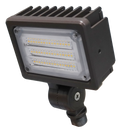
14 Products
Typical categories include area/parking lot lights (shoebox), flood lights, wall packs, canopy lights, bollards, and post-tops. Each is optimized for a specific mounting method and beam distribution.
Type II/III suit walkways and lots at the edge of the pole line, Type IV throws forward for perimeters and building sides, and Type V provides symmetrical coverage for poles located more centrally.
3000 K feels warm for pedestrian areas, 4000 K balances comfort and visibility, and 5000 K maximizes contrast for security. Check local preferences or light-pollution guidance before selecting very cool CCTs.
Use full-cutoff optics, select fixtures with appropriate BUG ratings, add house-side/back-light shields, and avoid tilting heads upward. Choose a distribution that matches the site geometry.
Yes—LEDs excel in cold climates. Verify the fixture’s operating temperature range. For integral emergency battery options, ensure the pack is rated for your lowest expected ambient.
It depends on mounting height, spacing, and task. Smaller entries and pathways may use lower-wattage floods or bollards, while 20–30 ft poles over lots typically need medium- to high-output area lights. Photometric layouts provide the most reliable sizing.
Photocells switch on at dusk/off at dawn. Motion sensors brighten when activity is detected and dim otherwise. Networked nodes (NEMA pin) enable scheduling, dimming, and remote monitoring across many fixtures.
Many are—look for DLC-listed models. Rebates vary by utility; efficiency tiers (e.g., DLC Premium) often qualify for higher incentives.
Yes. Some luminaires include UL 924 battery backup or can be fed from a life-safety circuit/generator to deliver the required 90 minutes along egress paths. Always confirm with the Authority Having Jurisdiction.
IP/NEMA for water/dust, IK for impact, surge protection (kV), corrosion-resistant finishes, and in some pole-mounted cases a 3G vibration rating for roadway environments.
Use them on large campuses and industrial sites with high-voltage distribution. Most commercial buildings use 120–277 V drivers.
Specify NEMA 4X or marine-grade finishes, stainless hardware, and sealed optics to combat salt fog and corrosion. Regular rinse-downs extend finish life.